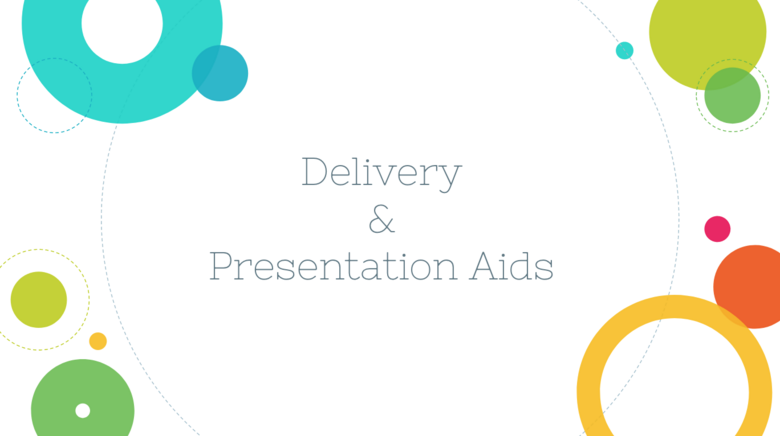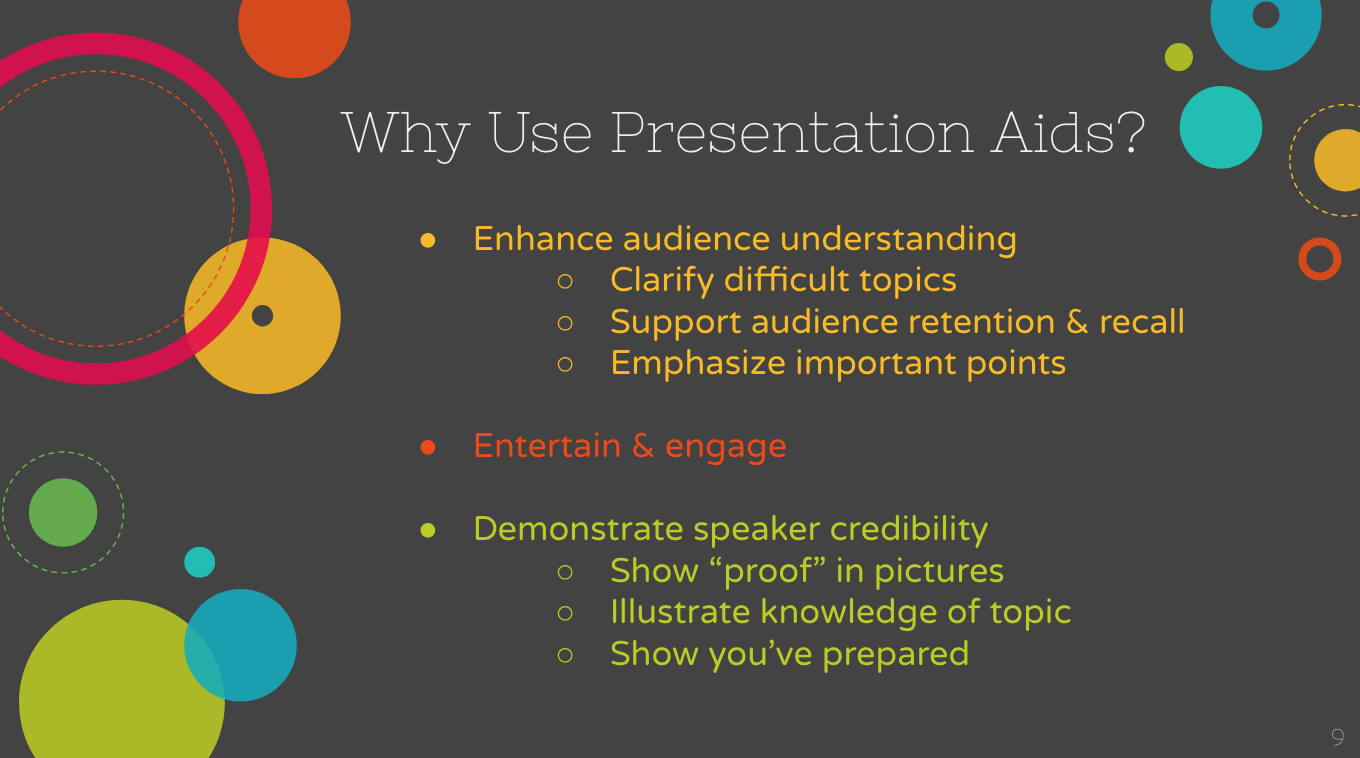Delivery & Presentation Aids Resources

Overview
By this point, you’re probably aware that delivering your speech is only one part of the public speaking process. Clearly, it’s a critical part of the process, and most likely, the only part that your audience will see, so it’s important to get it right. Strong, confident delivery can help you build rapport and trust among your audience. Supporting your speech with effective presentation aids will help increase audience interest and hopefully understanding of your important ideas. This section will go over several strategies for how to make the most of your time in the spotlight, on stage, in class, or in the corporate boardroom. Part one of this topic deals with the actual delivery of the speech. Part two of this section deals with the development and use of presentation aids. Upon completion of this unit, students should be equipped with practical strategies that they can use to deliver dynamic, engaging, and memorable speeches, no matter the situation. Of course, it takes practice to develop good speech delivery habits, so students should be encouraged to take extra time to form these skills. With support and guidance, even the most timid students can make great strides toward developing a strong “presence” that audiences will really respond to!
Learning Objectives
After completing this section, students should be able to:
- Understand the principles of dynamic speech delivery
- Explain delivery modes/methods such as extemporaneous, impromptu, memorized, manuscript, etc.
- Articulate effective practice techniques
- Understand types of presentation aids
- Understand guidelines for selecting, creating, and using presentational aids
- Work effectively with technological media for the creation of presentation aids
(This Module meets the TAG/OCM 013 for a Public Speaking Course; Learning Outcome 2)
Recommended Textbook Resources
Stand up, Speak out: The Practice and Ethics of Public Speaking 
Chapter 14: Delivering the Speech
14.1 Four Methods of Delivery
14.2 Speaking Contexts That Affect Delivery
14.3 Using Notes Effectively
14.4 Practicing for Successful Speech Delivery
Chapter 15: Presentation Aids: Design and Usage
15.1 Functions of Presentation Aids
15.2 Types of Presentation Aids
15.3 Media to Use for Presentation Aids
15.4 Tips for Preparing Presentation Aids
Exploring Public Speaking

Chapter 9: Presentation Aids in Speaking
- 9.1 What Are Presentation Aids?
- 9.2 Functions of Presentation Aids
- 9.3 Types of Presentation Aids
- 9.4 Using Presentation Slides
- 9.5 Low-Tech Presentation Aids
Chapter 11: Delivery
- 11.1 The Importance of Delivery
- 11.2 Methods of Speech Delivery
- 11.3 Preparing For Your Delivery
- 11.4 Practicing Your Delivery
- 11.5 What to Do When Delivering Your Speech
These chapters cover most of the important aspects of delivering an effective speech and supporting one’s delivery with presentation aids. They align very closely (if not exactly) with the OCM/SLO for this section. The chapters were selected by the content contributor for their comprehensive topic coverage; clear, engaging language, thorough supporting sources from some of the leading scholars in the field; and of course, the publisher’s commitment to open educational resources.
Stand up, Speak out: The Practice and Ethics of Public Speaking 
Chapter 14: Delivering the Speech
14.1 Four Methods of Delivery
14.2 Speaking Contexts That Affect Delivery
14.3 Using Notes Effectively
14.4 Practicing for Successful Speech Delivery
Chapter 15: Presentation Aids: Design and Usage
15.1 Functions of Presentation Aids
15.2 Types of Presentation Aids
15.3 Media to Use for Presentation Aids
15.4 Tips for Preparing Presentation Aids
Exploring Public Speaking

Chapter 9: Presentation Aids in Speaking
- 9.1 What Are Presentation Aids?
- 9.2 Functions of Presentation Aids
- 9.3 Types of Presentation Aids
- 9.4 Using Presentation Slides
- 9.5 Low-Tech Presentation Aids
Chapter 11: Delivery
- 11.1 The Importance of Delivery
- 11.2 Methods of Speech Delivery
- 11.3 Preparing For Your Delivery
- 11.4 Practicing Your Delivery
- 11.5 What to Do When Delivering Your Speech
These chapters cover most of the important aspects of delivering an effective speech and supporting one’s delivery with presentation aids. They align very closely (if not exactly) with the OCM/SLO for this section. The chapters were selected by the content contributor for their comprehensive topic coverage; clear, engaging language, thorough supporting sources from some of the leading scholars in the field; and of course, the publisher’s commitment to open educational resources.
Supplemental Content/Alternative Resources
Video Resources:
Vocal Branding: How Your Voice Shapes Your Communication Image
by Wendy LeBorgne | TEDxUCincinnati
How to speak so that people want to listen
by Julian Treasure
7 Differences Between Good and Great Speakers
by Dianna Booher
The Skill of Humor
by Andrew Tarvin | TEDxTAMU
How to avoid death By PowerPoint
By David JP Phillips | TEDxStockholmSalon
Presenting & Public Speaking Tips - How to improve skills & confidence
By The Mobile Studio Company
Resources for learning and using presentation software:
*Note: There are many different software options for building presentation aids, and the authors do not endorse any one in particular. The following guides are presented as references for students and teachers that already have access to a particular software title.
How to Learn PowerPoint Quickly (Complete Beginner's Guide)
Envato Tuts+
Google Drive & Google Slides Tutorials
Goodwill Community Foundation Inc.
Get started with Slides - Overview: What can you do with Slides?
GSuite Learning Center
Getting started with Prezi Next
Prezi Support
Overview of Keynote for Mac and iOS
Apple Support
Keynote User Guide (for Mac)
Apple Support
PowerPoint Slides

Topic Application Section
The topic application area is divided into two sections: exercises for delivery, and exercises for presentation aids. There is some crossover in terms of learning outcomes in the following exercises, and instructors should take advantage of the additional opportunities for student practice, peer critiques, instructor feedback, and formal assessment.
Activities for Delivery
Performative Speaking Exercise
For this assignment, students can pick (or are assigned) a short monologue, dialogue, or other text-based source. For example, scenes from popular movies, excerpts from plays, poems, song lyrics, or books. The piece should produce approximately 2-3 minutes of speaking and performance. Students should be encouraged to be (overly) dramatic; they should practice using large, emotive gestures, posturing and kinesics, accents or dialects, and wide ranges of vocal dynamics. Props, sound effects, and costumes could be used in support of the performance as well. Instructors can assist students in picking sources that will allow for maximum performance value.
While this activity may be uncomfortable for some students, especially those with communication apprehension or public speaking anxiety, it can be very productive for breaking some students out of their shells. As always, instructors should work to make sure that the classroom is a place where all students can feel comfortable expressing themselves in this way, and should provide clear expectations to the class in advance of this exercise.
As a debriefing exercise, the instructor can lead the class in discussing how different types of delivery felt during the performances. Questions could focus on breathing, vocal quality, vocalics, nonverbal cues, facial expressions (including eye contact), and what contributed to the student’s overall “persona” during the performance.
Speech Workshops
Prior to each “major” speaking assignment in the class (e.g., the informative, persuasive, or performative speeches), instructors can offer a workshop session in which each student has the opportunity to present a short (no more than 30 sec.) part of their speech to their classmates. The expectation is that this is not a finished speech, but rather a first draft that will help the students further hone their writing, support, arguments, and delivery. Students are encouraged to try out their attention-getting devices or clinchers, or practice passages that include difficult words, numbers/data, or tricky delivery techniques like dynamic pacing, volume, or prosody.
Peers are encouraged to provide constructive feedback on the speaker’s workshop presentation. This encourages every student to develop a more critical approach to public speaking, while also helping them develop the language of speech critique.
The speech workshop assignment encourages students to be prepared in advance of their final presentations (a MAJOR boost in confidence) and also gives them yet another opportunity to practice a short, low-stakes presentation in front of an audience. Instructors should provide clear and actionable recommendations for each student, though, again, students should receive full points for participating in the workshop exercise.
Activities for Designing and Using Presentation Aids
Picture storytelling
For this exercise, students are asked to tell an impromptu story based on a photograph. Instructors should prepare a cache of pictures taken from magazines or newspapers that do not contain words, or explicitly imply an existing story. For example, a child walking in a field; a woman listening to headphones at a table; a family seated in a busy city; overhead group shot; or a couple standing in front of a generically-lit backdrop.
Each student (or pairs if needed for time and class size) receives one photo and must describe what happened before, during, and after the photo was taken. Speeches should be no more than 2 minutes, and the goal is to have the students practice using the image in support of their story. The focus should be on clear presentation, timing, and not fidgeting with or talking at the picture.
Delivery & Presentation Aid Strategy Development
One of the most important parts of preparing for a speech is understanding your audience (audience analysis) and the context in which your speech will be taking place (context analysis). Knowing this information will help the speaker develop presentation aids and a delivery style that will be most effective for the particular speech. In this activity, students are asked to develop a strategy for presenting a given topic to a particular audience.
Preparation: On a small slip of paper, have each student write out a potential public speaking audience. Example audiences could include a fraternity or sorority, a class, a family wedding, a book club, city council, business executives, or an academic conference. Next, on another slip of paper, have students write out a topic for a speech. For example, How to bathe a dog; history of cheesemaking in France; Automobile maintenance on a budget; the invention of the violin; or become an organ donor. Shuffle each pile of topics and audiences, keeping the two separate.
Encourage creativity here, since more random pairings will challenge students to be more creative with the next step of this exercise.
Divide students into pairs, and have them select one topic and one audience from the piles of papers. Thus, a group may end up with the task of presenting on “Automobile maintenance on a budget” to a group of business executives.
The activity: First, have the students come up with why they might be presenting this topic to this particular audience. Have them develop a few goals or the purpose of the speech. Next, students should develop a high-level approach for how they might deliver such a speech. Have them consider language, verbal style, register, movement, appearance, and energy. Finally, have students brainstorm and describe 3 presentation aids they would use to support their speech. They should consider style, format, content, and of course, strategies for effective use.
After 10 minutes or so, have each pair present their strategy to the class. Peer feedback and discussion should be encouraged at this stage.
End of Section Review
Summary
This topic has addressed how to effectively deliver a public address through verbal and nonverbal channels, and has provided an overview of supporting one’s speech with presentation aids. The topic first provided an overview of what is meant by “dynamic delivery” and why it is important for the public speaker. Next, the section presented students with different contexts that affect delivery along with suggestions for meeting those challenges. Students were given keys for practicing and perfecting their delivery; notably, consistent practice was identified as one of the most critical aspects of developing a confident, controlled delivery.
This topic also covered the importance, function, design and development, and use of presentation aids. Here, students are encouraged to think beyond just “visual aids,” to include materials that support the speech through all 5 senses! Students were given the opportunity to consider how PAs can be used to serve different functions (e.g., pie chart vs. video), and learned how PAs contribute to effective, dynamic delivery. This topic also discussed several potential challenges when working with PAs and provided tips for how to avoid misusing supporting materials during the speech.
Key Terms
- Conversational style
- Extemporaneous speaking
- Impromptu speaking
- Manuscript speaking
- Memorized speeches
- Verbal & nonverbal communication
- Vocalics
- Rate/speed
- Volume
- Pitch
- Prosody
- Vocal variety (dynamics)
- Articulation & Pronunciation
- Substitution
- Omission
- Distortion
- Addition
- Verbal surrogates / audible pauses
- Verbal variety
- Eye contact
Review Questions
- What is meant by “dynamic delivery”?
- Why is dynamic delivery important?
- What are the four modes of delivery?
- What are the factors that can affect successful delivery?
- Describe the 5-card method, and explain why it is useful in public speaking.
- List four reasons why presentation aids are important in public speaking.
- Identify several types of presentation aids, making sure to pay attention to ALL of our senses, not just sight.
- Articulate some of the differences between effective and ineffective presentation aids
- Identify 3-5 techniques for using presentation aids effectively.
- What are some things that can go wrong when working with presentation aids? How can you avoid (or deal with) these issues?
Critical Thinking Questions
- Compare and contrast 2 or 3 presentations or speeches you’ve seen recently, with a particular emphasis on delivery… which was most engaging? Which one helped you recall or learn the most? Describe what the speaker did to be effective.
- Identify a speaking context when each of the four modes of delivery is appropriate and when they are not. Be specific.
- Describe the function that eye contact serves in the social contract between speaker and audience. How much is too much, and what about not enough?
- Describe 3-5 benefits/advantages of using notecards or a short-sentence outline.
- Using what you’ve learned about effective delivery preparation, come up with 3-5 tips for a friend, colleague, or classmate that might help them get ready for their next speech.
- How does audience and context analysis help inform the choices you make when it comes to delivery and presentation aids? Come up with 2-3 examples.
- Think of a time when you’ve seen a presenter use presentation aids very effectively (or not well at all); what did the materials look like, and how did the speaker use them?
- Discuss the merits and drawbacks of passing a presentation aid around the room during your speech… is it helpful or distracting? Is it always a “no-no” or can you think of a situation in which it would be acceptable?